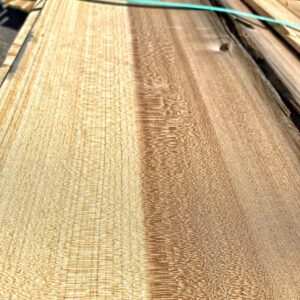Quarter Sawn Poplar Lumber
Quartersawn Poplar Wood Cost

Technical Information
- Scientific name: Liriodendron tulipifera
- Alternative Names: Yellow Poplar, American Tulipwood, White Poplar
- Region of Origin: North America (primarily East Coast)
- Average Dried Weight: 30 LB/cubic foot
- Janka Hardness Rating: 545
- Specific Gravity: .47
- IUCN Red List: No
- CITES wood: No
What is Quartersawn Wood?
Quarter sawn lumber is wood sawn at the sawmill using a quarter-sawing process. Consequently, each log is sawn at an angle into four quarters. Accordingly, the grain-lines on the lumber face appear mostly vertical & uniform. Additionally, medullary rays appear on certain areas of the lumber face.
What is poplar wood good for?
Poplar uses include construction plywood, construction grade lumber and custom millwork. Additionally, Poplar paints, finishes and glues well. Thus, it’s frequently found in woodworking projects, cabinetry and drawer-side applications. Most woodworkers agree that poplar lumber machines significantly better than pine.
A stable and inexpensive wood, poplar lumber is not often used in fine furniture. The reason is its typically bland appearance. Often, poplar wood colors run from pale white to greenish brown. Two notable exceptions are paint grade furniture (or painted poplar drawer-sides) and rainbow poplar slabs.
Rainbow Poplar
Rainbow Poplar refers to the wood’s appearance rather than its specie (similar to birdseye maple and quilt maple). Rainbow describes the bright and contrasting white, brown, green and black colors. These colors are featured, rather than hidden or painted over.
Poplar is ideal for timber framing. All of the 30 species of tulip Poplar are strong and stable enough to make structurally sound timber framing. It is officially a hardwood. (angiosperm). However, it is a low density hardwood. Thus, it machines well and is easy on knives and tooling.
Why Use Quarter Sawn Poplar?
Quarter Sawn lumber is produced when the log is cut into four quarters (hence the name), then each quarter is flat-sawn. The growth rings are generally 60-90 degrees to the face of the board, resulting in a more linear grain pattern without the “cathedral” effect. In Red Oak and White Oak, this cut also shows a flecking or ray in the grain. Since this type of cut involves more labor and produces more waste, the cost is higher than plain sawn lumber. Due to the position of the growth rings in the cut, Quarter Sawn lumber is more dimensionally stable than Plain Sawn. It resists expansion and contraction on plank’s width.


Pingback: 🌳 Black Limba Wood - A Helpful Illustrated Guide - 2020
Pingback: Marbled Padauk Figured Wood - Commercial Forest Products
Pingback: 10 Best Hardwoods For Woodworking By A Hardwood Lumber Pro - Commercial Forest Products
Pingback: AYOUS LUMBER | OBECHE WOOD | WAWA | SAMBA - Commercial Forest Products
Pingback: Best Hardwoods For Model Making 2021 - Commercial Forest Products
Pingback: EASY Lumber Weight 101: How Much Does Lumber Weigh? - Commercial Forest Products
Pingback: How Much Lumber Fits In A 40' Container? - 2021
Pingback: Jelutong Lumber: Amazing Asian Wood! 2022 - Commercial Forest Products
Pingback: Spalted Wood ~ Spalting Lumber 2022 - Commercial Forest Products
Pingback: Spoon Carving Wood: Is Kiln Dried Hardwood OK? - Commercial Forest Products
Pingback: What Is Primavera Wood? 2022 - Commercial Forest Products
Pingback: Korina Neck Blanks ~ White Limba Guitar Wood - Commercial Forest Products
Pingback: Wood Blank Dimensions Guide 2022 - Commercial Forest Products
Pingback: 7 SMART Woodworking Tools At Harbor Freight 2022 - Commercial Forest Products
Pingback: Roasted Alder Wood 2023 - Commercial Forest Products
Pingback: Quartersawn Maple: A Helpful Illustrated Guide To Hardwood - 2019 ?
Pingback: Fractal Wood Burning: TikTok's Dangerous Woodworking Trend
Pingback: Iroko Wood Is African Teak Lumber 2023
Pingback: Leaf Maple: Maple Wood Identification 2023